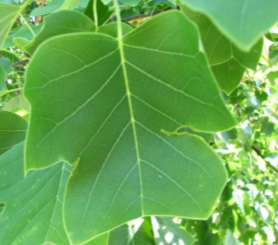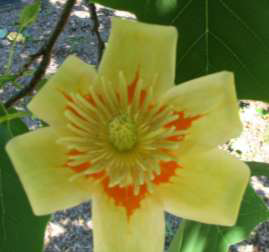 Tulip Poplar
Tulip Poplar
(Liriodendron tulipifera L)
|
Classification |
| Kingdom: |
Plantae |
| Division: |
Magnoliophyta |
| Class: |
Magnoliopsida |
| Order: |
Magnoliales |
| Family: |
Magnoliaceae |
| Genus: |
Liriodendron |
| Species: |
tulipifera |
 Characteristics: Tulip poplar is a member of the magnolia family. The smooth leaves are tulip-shaped, alternate, and simple. Twigs are moderately stout, olive-brown, to reddish brown, very smooth and usually lustrous; the large terminal bud has two large duck-bill shaped scales. The bark on younger trunks and branches is quite smooth, light ashy-gray with very shallow, longitudinal, whitish furrows. With age the bark becomes very thick; having deep interlacing furrows and rather narrow rounded ridges. This tree is rapid growing, attaining heights of 80 to 120 feet and a trunk diameter of 2 to 5 feet. Tulip poplar produces tulip-shaped, light greenish-yellow flowers from April to June. The fruit form in cone shaped clusters.
Characteristics: Tulip poplar is a member of the magnolia family. The smooth leaves are tulip-shaped, alternate, and simple. Twigs are moderately stout, olive-brown, to reddish brown, very smooth and usually lustrous; the large terminal bud has two large duck-bill shaped scales. The bark on younger trunks and branches is quite smooth, light ashy-gray with very shallow, longitudinal, whitish furrows. With age the bark becomes very thick; having deep interlacing furrows and rather narrow rounded ridges. This tree is rapid growing, attaining heights of 80 to 120 feet and a trunk diameter of 2 to 5 feet. Tulip poplar produces tulip-shaped, light greenish-yellow flowers from April to June. The fruit form in cone shaped clusters.
Habitat: Tulip poplar does best on moderately moist, deep, well drained, loose textured soils; it rarely grows well in very dry or very wet situations with a pH of 4.5 to 7.5.
Range: It is found throughout the eastern and southeastern regions of the United States.
Uses: The wood of tulip poplar is moderately light, soft, brittle, moderately weak, and is very easily worked. It is used for furniture stock, veneer and pulpwood. Tulip poplar makes a desirable street, shade, or ornamental tree, but the large size it attains makes it unsuited for many sites. This species has some wildlife value. The fruits provide food for squirrels in the late fall and winter months, and the white-tailed deer often browse on the twigs.
Native American Uses: Infusions of the bark were used to treat pinworms, diarrhea, dysentery, and infant cholera. In addition, the bark was used to make cough syrup and a fever reducer, and a decoction was blown onto wounds and boils. They also used the tree to make honey and cordage. A poultice was made from bruised leaves and was bound to the head for neuralgic pain and the raw, green bark was chewed as a
stimulant. The Cherokee and the Rappahannock are among the Native American tribes known to have utilized this species.